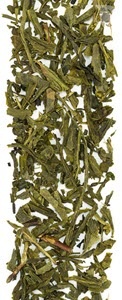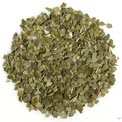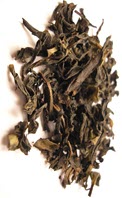Teas with Weight Loss Benefits
Everybody knows about the major players in the tea world. We have green tea, black tea, white tea, and oolong tea, and a wide variety of herbal teas that are mixed and matched for various reasons. This can make it confusing when you're trying to figure out which tea you should start drinking. Obviously, it depends on what you want to get out of your tea. Whether you just want to drink a tasty beverage, or whether you want extra health benefits from Mother Nature's beverage of choice, there are three varieties in particular that will give you everything you've ever wanted from a hot, steamy cup of tea - and more!
Sencha Green Tea
 When you hear the word "sencha" in the description, you may be asking yourself "what's the difference between regular and 'sencha' green tea?" well, it's actually pretty simple. Although sencha and regular green tea both come from the same camellia sinensis plant, the two main differences between sencha green tea and other forms of green tea are twofold. For starters, in order to qualify as sencha, the tea must be grown in direct sunlight. This changes the botanical composition of the tea leaves, leading to higher levels of beneficial polyphenols such as EGCG. Next, unlike regular tea, it is usually not consumed in looseleaf form.
When you hear the word "sencha" in the description, you may be asking yourself "what's the difference between regular and 'sencha' green tea?" well, it's actually pretty simple. Although sencha and regular green tea both come from the same camellia sinensis plant, the two main differences between sencha green tea and other forms of green tea are twofold. For starters, in order to qualify as sencha, the tea must be grown in direct sunlight. This changes the botanical composition of the tea leaves, leading to higher levels of beneficial polyphenols such as EGCG. Next, unlike regular tea, it is usually not consumed in looseleaf form.
When it comes to sencha tea, it has two main bragging rights with regard to its health benefits: growing in direct sunlight allows it to build up a greater number of antioxidants, polyphenols, and botanical extracts which are beneficial to the human body. Furthermore, it is very common for sencha to be ground up into a powder and mixed with hot water. Because you're consuming the whole tea leaf, as opposed to steeping whole leaves in boiling water, you are compounding the amount of nutrition that you get from the tea. Sencha tea has a wide variety of micronutrients that you won't be able to get from traditional tea, and even has great benefits for weight loss. It can help you maintain a healthy blood sugar level, improve your metabolic function, increase your metabolism, and even help delay the onset of diabetes.
Drinking sencha tea by brewing the loose leaves requires a very delicate and complicated process if you want to follow classic Japanese tradition. For this reason, and because the tea leaves keep better when being transported across the globe, most people drink sencha tea in powdered form. For even more flavor (plus antioxidant benefits), you can brew this variety of tea with spearmint and lemongrass herbs.
Yerba Mate Tea
 Unlike the difference between sencha and regular green tea, the differences between regular green tea and yerba mate are much more extensive. For starters, yerba mate comes from a completely different plant and a completely different continent. For this reason, most traditional tea drinkers argue that it is not in fact tea at all; despite the fact that it is grown, harvested, brewed, and consumed in very similar ways. Although the green tea plant is native to Asian countries, yerba mate leaves are picked from the ilex paraguariensis tree, which is native to South America. The best varieties grow in the shade, rather than indirect sunlight. This helps protect the leaves from UV damage that would otherwise make them taste bad and have less nutritional value.
Unlike the difference between sencha and regular green tea, the differences between regular green tea and yerba mate are much more extensive. For starters, yerba mate comes from a completely different plant and a completely different continent. For this reason, most traditional tea drinkers argue that it is not in fact tea at all; despite the fact that it is grown, harvested, brewed, and consumed in very similar ways. Although the green tea plant is native to Asian countries, yerba mate leaves are picked from the ilex paraguariensis tree, which is native to South America. The best varieties grow in the shade, rather than indirect sunlight. This helps protect the leaves from UV damage that would otherwise make them taste bad and have less nutritional value.
Scientific analysis of this unique plant have identified more than 39 different minerals, amino acids, vitamins, and antioxidants. Yerba mate also contains a significant amount of caffeine, which contributes to full-body thermogenesis. When your body revs up your metabolism in this way, you will burn more calories throughout the day which will contribute to some significant weight loss.
One traditional way to prepare yerba mate is to let the tea leaves soak in a small amount of warm water in a mate cup for about 30 seconds, followed by filling the rest of the cup with hot water. If you're drinking it loose leaf in a traditional cup, you should also have a filtered straw which allows you to drink the beverage without ingesting the loose leaves. For an added bonus, You could add some orange peel or ginseng to help unlock it's weight loss benefits.
Oolong Tea
 Oolong tea is a member of the green tea family, and actually originates from the exact same plant. They only truly differ in how they are grown, and how they are processed after they're picked. Most green tea is either grown in the sun or the shade in hospitable, cool climates. Oolong tea, however, has to grow in much harsher conditions with less access to sunlight. After picking, it is allowed to oxidize for a brief period of time depending on the type of flavor the tea master is trying to achieve (unlike it's cousin, green tea, whose leaves are processed immediately after picking).The leaves are intentionally bruised, cooled, lightly rolled, roasted, rolled a second time, and allowed to try before being sold to the public or consumed.
Oolong tea is a member of the green tea family, and actually originates from the exact same plant. They only truly differ in how they are grown, and how they are processed after they're picked. Most green tea is either grown in the sun or the shade in hospitable, cool climates. Oolong tea, however, has to grow in much harsher conditions with less access to sunlight. After picking, it is allowed to oxidize for a brief period of time depending on the type of flavor the tea master is trying to achieve (unlike it's cousin, green tea, whose leaves are processed immediately after picking).The leaves are intentionally bruised, cooled, lightly rolled, roasted, rolled a second time, and allowed to try before being sold to the public or consumed.
As with any caffeinated beverage, drinking oolong tea helps increase the number of calories you burn in any given day. But there's more to it than just the caffeine. A study from 2001 proved that, versus caffeine alone, oolong tea increases your body's fat oxidation by upwards of 12%. So it's not just about burning calories - it's about losing the weight you actually want to lose.
Like most classic tee preparations, you'll get the most out of your oolong if you steep it from 1 to 5 minutes in water that has been heated to 180-200 degrees Fahrenheit. And if you're making it loose leaf, try adding in some senna or some hawthorn for added weight loss benefits.
Well, there you have it. Not only are these exotic and flavorful teas great to enjoy on their own, but you can sip away knowing that you're getting fantastic weight loss and other health benefits. Who knew you could get so much from such a little cup of tea? For our review of one new detox tea, click here.
